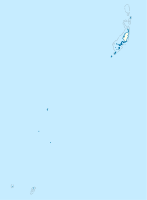Imeong Conservation Area
|
Imeong Conservation Area
|
||
| location | Ngeremlengui , Palau | |
| surface | 3263 km² | |
| Geographical location | 7 ° 32 ' N , 134 ° 32' E | |
|
|
||
The Imeong Conservation Area is a protected area with an area of approximately 3263.3 km² (1,250 sqm) in the west of the island of Babeldaob in the island state of Palau . The reserve is not only intended to protect the natural areas, but also the important cultural sites within.
geography
The reserve extends over the south of the administrative state (administrative area) of Ngeremlengui and is separated from Ngatpang by Karamadoo Bay . The area is home to some of the island's highest peaks, which also creates important river systems for the west of the island. The area is dominated by the four mountains Etiruir , Tmerou , Sechedui and Ngeruach . Etiruir is the second highest mountain in Palau with a height of 213 m above sea level .
Ecosystems
The area contains numerous different habitats and ecosystems, including rainforests , savannahs and mangrove swamps . Numerous small rivers flow into the mangroves and sharp ridges form in the landscape.
Historic sites
In addition to the natural treasures, there are also numerous historical sites in the area. Among other things, the Ii ra Milad -Sacred Rock Shelter, the holiest place in Palau, as well as Ngeruach and the Ngerutechei -Traditional Village. Ii ra Milad is a grotto that used to be a shelter and through which a small stream flows. There are several bowl-shaped depressions (mortar or hollowed areas) and petroglyphs . In World War II and lived Japanese soldiers in the field and you can find ammunition and other artifacts. Milad is the name of a goddess who is said to have lived in the grotto and who is revered as the great mother of all Palau people.
The Ngerutechei Traditional Village is a well-preserved example of a traditional Palau village with stone paths between the house terraces, bathing pools, the Council of Chiefs Meeting House , boat docks and others. The related traditions say that there the gods handed over the chief titles to the people of Imong. Other older sites are terraces in the savannah, which are said to have emerged in the last century BC. And the historical sites also include several Japanese defense complexes.
flora
A 2004 study collected over 100 different plant species from 57 families with 15 endemic and 59 native species. Some unidentified specimens were also found. In the valley of Sechedui and Ngeruach 94 bird species from 12 families were counted, 10 of which are endemic to Palau.
World natural heritage
The area was placed on the tentative list of UNESCO World Heritage on August 26, 2004 in the Mixed (Cultural + Natural) category .
Individual evidence
Web links
- Imeong Conservation Area - UNESCO World Heritage Center Consulted May 8, 2020.
